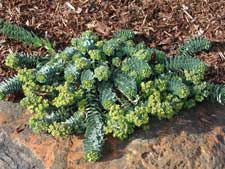Resource Library
Plant of the Week: Spurge, Myrtle
The University of Arkansas System Division of Agriculture does not promote, support or recommend plants featured in "Plant of the Week." Please consult your local Extension office for plants suitable for your region.
Plant of the Week
Myrtle Spurge
Latin: Euphorbia myrsinites

Nobody's perfect, or so we are told. The same is true of garden plants. Part of the fun of gardening is to grow an assortment of plants and decide for yourself which you like and learn the merits and shortcomings of each.
A few plants though, such as the Myrtle or Donkeytail Spurge (Euphorbia myrsinites), harbor secrets you really don't want to learn about first hand.
Myrtle spurge is a sprawling evergreen perennial belonging to the euphorbia family. It grows about 8 inches tall and sends outs sprawling branches covered with waxy, blue-gray leaves. The sessile leaves are about an inch long and tightly clustered down the stem in a congested spiral.
The flowers appear in terminal clusters in early spring at the ends of branches. The true flowers are small yellow, petal-less affairs called "cyathia" clustered inside a bowl-shaped structure consisting of two yellow cup-shaped bracts. These cups are three-fourths of an inch across but clustered together to form an inflorescence 3 inches to 4 inches across. Seeds are produced freely.
Myrtle spurge is native to southeastern Europe and central Asia. A century ago, Bailey called it "a plant of old gardens," but it faded from the garden scene during the middle years of the 20th century. Of late, it has reappeared and is commonly seen in garden centers and home gardens throughout a large part of the United States.
The secret myrtle spurge harbors is that its sap, just like the sap of many other euphorbias, can cause extreme allergic reaction in some individuals, including me. Like a bee sting or a peanut allergy, contact with sap from certain Euphorbia species can cause an anaphylactic shock reaction. Most individuals show little reaction to the sap, or if they do, only develop a poison ivy-like rash.
I've now had three stressful encounters with Euphorbia sap, two resulting in emergency room visits. Two were classic anaphylactic shock reactions which are no fun, but compared to getting the sap in your eye, were a cake walk.
All I did was pick off a seed pod. Then sometime, in the next hour, I must have scratched an itch near my eye or perhaps rubbed my eye. The protein that was transferred from my finger to the tender skin around my eye must have been only a trace, but within an hour my eye began to burn. By the time the ophthalmologist looked at it, there were large, painful eruptions across the surface of both eyeballs. Though it was a painful experience, the pain only lasted two days and within a week my vision was back to normal.
Washing my hands after touching the plant – or better yet using gloves before pinching off the seed pod – would have prevented the problem. Rinsing the eye sooner probably would not have helped. According to one report, greenhouse workers who accidentally got sap directly in their eyes weren't able to avoid injury by immediate rinsing.
I know of no estimates of how many people are sensitive to Euphorbia sap. Peanut allergies affect about 1 percent of the population and it's likely this allergen has a similar kind of target audience.
I still grow a number of Euphorbias, including E. myrsinites, but I'm much more cautious when I work around it. Using gloves when working around any of the ornamental spurges seems like a sensible precaution for all gardeners, even for those showing no indication of sensitivity.
Myrtle spurge is an easy to grow perennial needing full sun and a well drained soil. Plants are hardy from zones 4 through 10. It tolerates drought well during the summer; in the winter good drainage is essential for long life. Its sprawling habit of growth makes it ideal for use in rock gardens or in the front of the border.
In the garden, it reseeds freely but is never really weedy. It just comes up here and there amongst the other plants, only living long term in dry perches where it gets the drainage it needs. In four western states, this species has been listed as a noxious weed where it has escaped cultivation. It is not reported to have escaped into the wild in the eastern states.
By: Gerald Klingaman, retired
Extension Horticulturist - Ornamentals
Extension News - June 1, 2007
The University of Arkansas System Division of Agriculture does not maintain lists of retail outlets where these plants can be purchased. Please check your local nursery or other retail outlets to ask about the availability of these plants for your growing area.